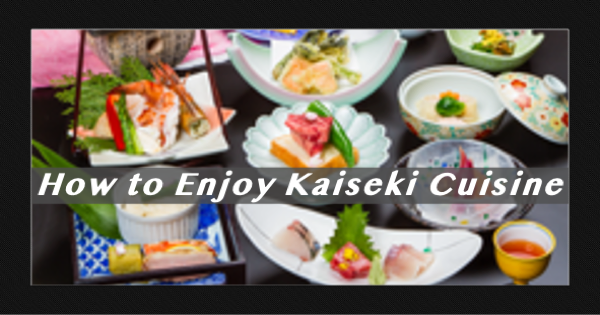On your trip to Japan, you will probably want to stay at a Japanese hot spring ryokan for at least one night. There are many fun things to do, such as bathing in a hot spring, sleeping on tatami mats, and taking photos in colored yukata. However, the kaiseki cuisine, decorated with luxurious items, is packed with the charm of Japanese cuisine. We recommend trying it at least once.
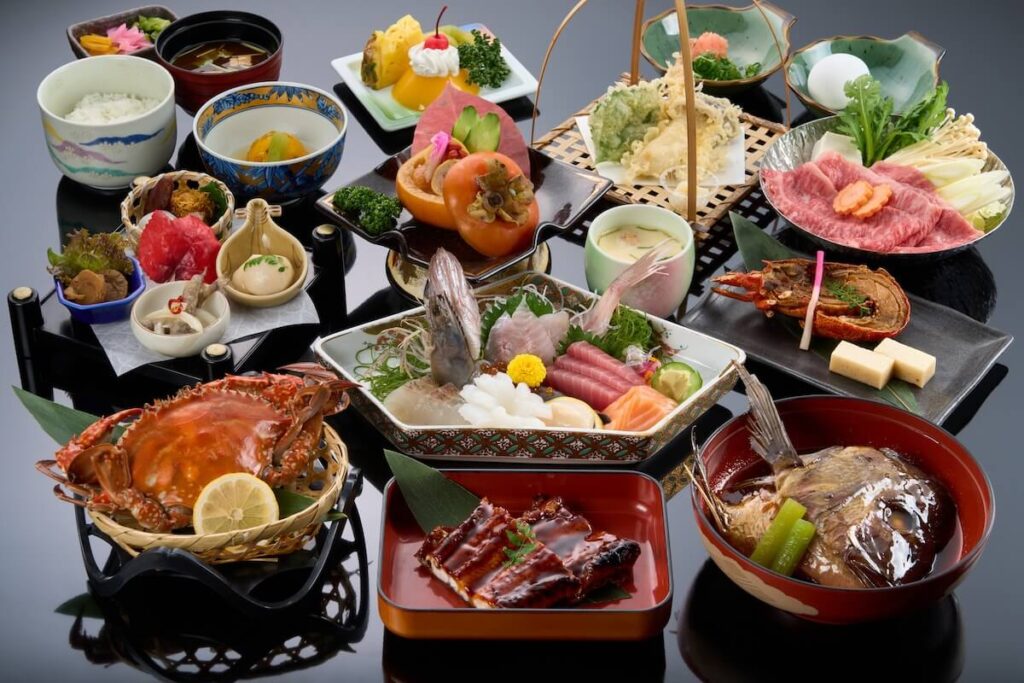
◆What is Kaiseki Cuisine?
Kaiseki ryori (kaiseki cuisine) is a course-style Japanese meal for enjoying alcohol. All senses are triggered from the original taste of locally produced ingredients of the season, the local way of life that can be felt through the cooking methods, to the colors of the four seasons. Many people have the impression that the “kuikiri’ method’, in which the dishes are served one by one in order, is difficult as there are so many rules, but in reality, the basic method is one soup and three side dishes. There are almost no rules.
★The “Kondate” (menu)
The “Kondate” (menu) is placed on the table. The menu details the dishes that will be served and the order in which they will be served.
Most ryokan menus are only in Japanese, meaning guests from overseas may have trouble understanding it. What is each dish like? What does it taste like? In what order should you eat them? How do you eat them? Many guests may be confused about how to enjoy kaiseki cuisine, so here we will introduce the basic ways to enjoy kaiseki cuisine.
*This is an example of kaiseki cuisine. The order and contents vary depending on the ryokan and chef.
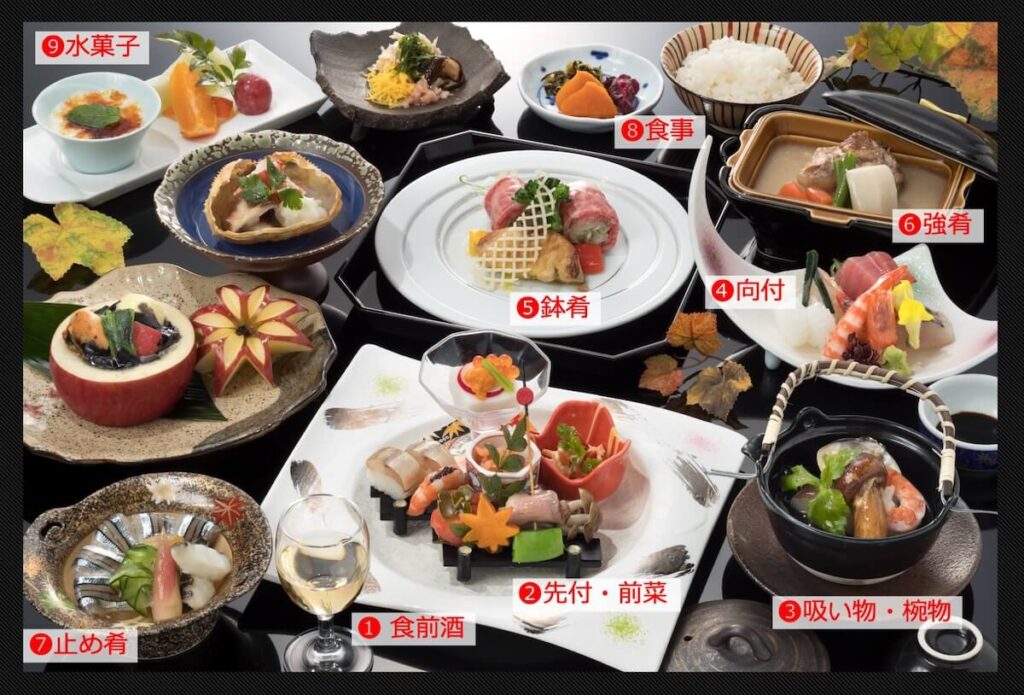
1. Shokuzenshu (aperitif)
As the Japanese name suggests, this is an alcoholic drink served before eating. Most are fruity drinks and are drunk before meals to increase appetite. Guests are not required to drink it all. You can continue drinking with the appetizer as a side dish.
2. Sakizuke/Zensai (appetizers)
The appetizer is a dish with a light taste that allows the taste of the ingredients to shine. After making a toast, the appetizer is first served as a side dish, bringing out the richness of the drink.
Appetizers bring out the season the most in kaiseki cuisine, with around five to eight colorful dishes centered around seasonal vegetables.
3. Suimono (soup)/Wan-mono (bowl dishes)
These are soup dishes using clear soup with seafood, vegetables, etc.
4. Mukozuke (sashimi plate)
It refers to “Otsukuri” (sashimi), which is arguably the centerpiece of Japanese cuisine. In some cases, the best fish of the day will be served, if there are multiple fish on the plate, such as a 3-piece platter, eat in order from white to red fish.

5. Hachizakana (grilled fish)
From here, we enter the middle stage of the meal, where grilled, simmered, or fried dishes appear.
Grilled food is one of the main dishes on the menu and is often simply grilled seasonal fish.Atsumono is a warm and juicy simmered dish made with vegetables and requires the delicate skill of the chef. The most typical fried dish is “tempura”, but crispy fried small fish and tatsuta-age (fried chicken) may also be served. In addition to seafood such as shrimp, seasonal ingredients such as matsutake mushrooms and vegetables are also often used in the dishes.
6. Shiizakana (savory dish)
This is a dish served as the second main dish. It is a dish made with meat, fish, vegetables, etc. that is paired with alcoholic beverages. There are no rules to the dish and has various cooking methods.
Grilled dishes, simmered dishes, and small pot dishes made using a stove are often served as “table dishes”.
★Sukiyaki
When sukiyaki is served on a table, it always comes with raw egg. This raw egg is the “sauce” used when eating sukiyaki. Dip the meat and vegetables from the pot into the raw egg before eating. This is the established way to eat sukiyaki, but if you don’t like raw eggs, do not feel obligated to use them and enjoy your meal in your preferred way.
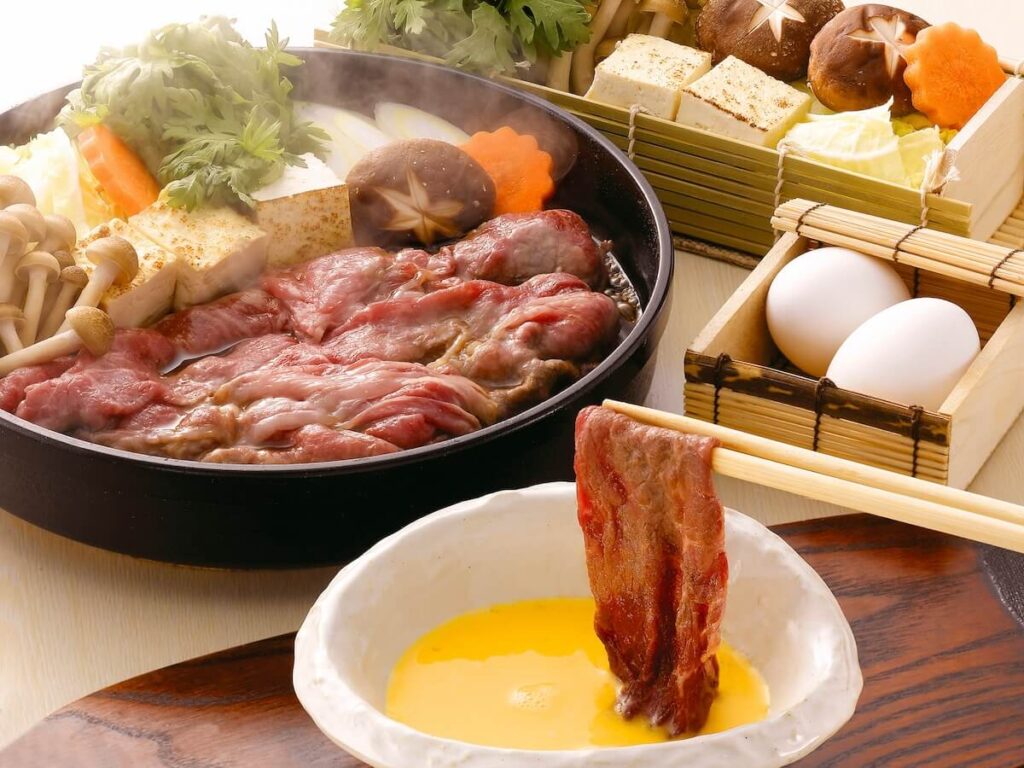
7. Tomezakana (palate cleanser)
This is a small bowl served between Shiizakana dishes and rice to cleanse the palate. These are generally vinegared dishes and “aemono” dishes using seasonal seafood and vegetables.
8. Shokuji (final dish)
This dish is the final stage of the course. In most cases, it consists of three items: “rice dishes” such as takikomi rice, sushi, and white rice, “tome bowls” such as miso soup or sashimi soup, and “konomono” (pickles).
*In a regular meal, rice, and side dishes are often eaten together, but because kaiseki cuisine is intended for enjoying conversation and drinking, the rice is served at the end. If you don’t drink much or wish to have the dishes out faster, just ask the waiter and they will generally be served early.
9. Mizugashi (dessert)
Originally meaning fruit, this is a dessert for kaiseki cuisine. In addition to fresh fruit, Japanese sweets such as anmitsu and yokan, and Western sweets such as sherbet and ice cream are also served.
This has been a summary of kaiseki cuisine and the order in which each dish is served. The way the menu is written, and the contents of dishes differ depending on the ryokan and the chef but being aware of the dishes and the order in which they are served should make having kaiseki cuisine a more enjoyable time.
Furthermore, your kaiseki cuisine experience may be improved by knowing the following three things.
1) Fish
Fish is an essential ingredient in Japanese cuisine, including sashimi, grilled fish, boiled fish, and vinegared dishes. The chef’s ingenuity can be seen in everything from the selection of the fish, the method of preparation, and seasoning, so be sure to pay close attention to the fish dishes when you enjoy a kaiseki meal.

2) Season
The kaiseki cuisine menu changes with the seasons and uses plenty of seasonal ingredients. The highlight of a chef’s skill is bringing out the flavor of each seasonal ingredient and allowing all five senses to experience the flavor and color of the season.

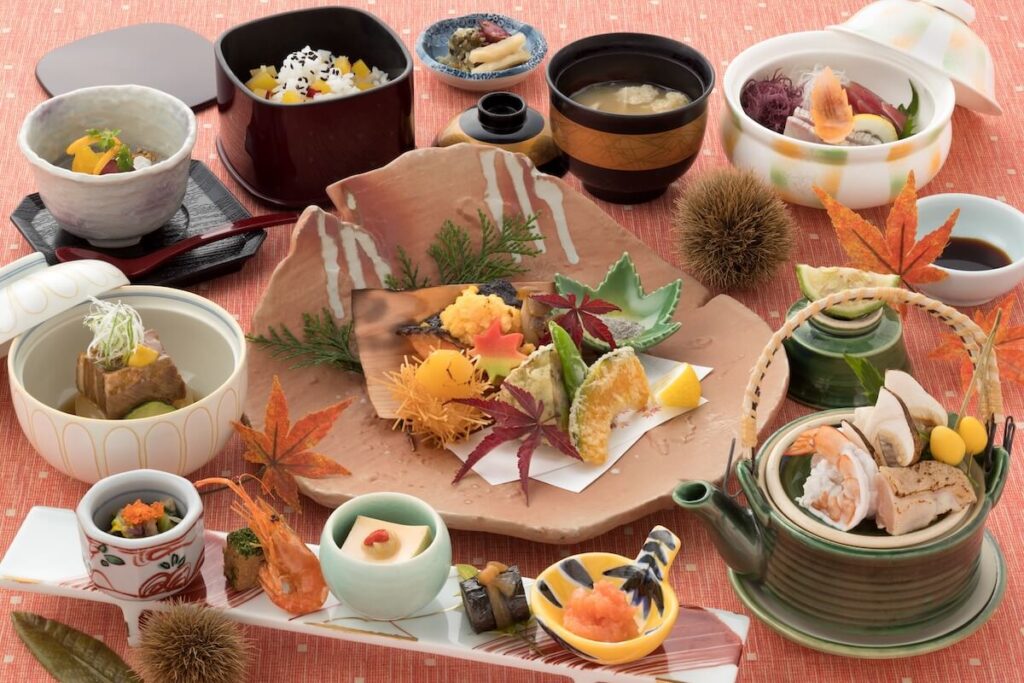
3) Dishware
It may be a little surprising, but the best part of kaiseki cuisine is selecting and using bowls and plates that match the color of the food and the season. Western cuisine courses are often made of white porcelain or glass, but Japanese kaiseki dishes use a variety of dishes, mainly ceramics, with unique colors, shapes, and textures.

That’s all for this piece on Kaiseki cuisine.
We’ll be constantly updating useful information to help foreign tourists enjoy their trip to Japan even more, so don’t miss out!
